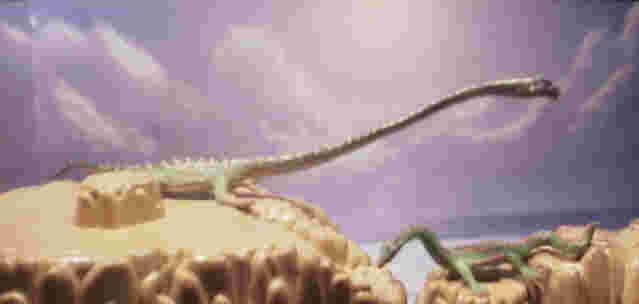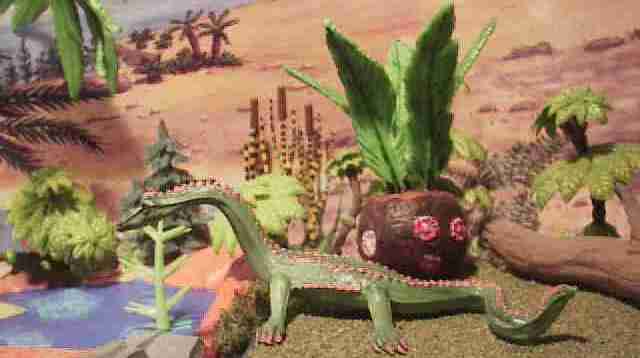
The Triassic Seas
from the Dinosaur Collector
In the final part of the great dying at the end of the Permian the seas proably became Anoxic. Marine fauna survived in refugia. Typical Permian forms the brachhiopods, trilobites, blastoids, and crinoids are gone or dimished. This triggered an explosion of marine diversity and a reorganiasation of the marine community. New forms of marine life evolve In the Triassic the most common Early Triassic hard-shelled marine invertebrates were bivalves, gastropods, ammonoids, echinoids, and a few articulate brachiopods. The most common Early Triassic hard-shelled marine invertebrates were bivalves, gastropods, ammonoids, echinoids, and a few articulate brachiopods. This mix of invertebrates constitutes the Modern Evolutionary fauna, even though most of these forms were also present in the Paleozoic Evolutionary Fauna. The same invertebrates were also present in the Paleozoic Evolutionary Fauna but the distibution is different. Sharks, boney fish and squids and their relatives survive the Permian extinction and diversify. A number of new orders of starfish, sea urchins and their relatives appear. Modern corals evolve, and in the equatorial Tethyan regions form small patch reefs no more than a meter high and often build on the decaying remains of sponge reefs. There are no massive reefs like those that exist today. Early Triassic recovery was fitful and inconsistent.
update 070511
More Diorama and pages
Three families of marine reptiles dominated the Triassic, the Placodonts, Nothosaurs and Ichthyosaurs. These Sea going reptiles are alike enough to be grouped together. They are the Placodonts, Nothosaurs, Plesiosaurs and Ichthyosaurs. Only the Ichthyosaurs survive into the Jurassic. A diversity of marine reptiles - the dolphin-like ichthyosaurs, the lizard-like pachypleurosaurs and thalattosaurs, the long-necked seal-like nothosaurs, walrus-like placodonts, the turtle-like henodonts, and the long-necked pistosaurs evolve to fill the empty niches. The oldest known aquatic turtles have been found and with amphibians are found in brachish waters. Odontochelys was an aquatic turtle, as the fossil specimens were found in marine deposits rife with conodonts and ammonites. It is theorized that the primitive turtle frequented shallow marine waters close to shore.
Ichthyosaurs, placodonts, pachypleurosaurs, and nothosaurs evolved in the Early Triassic.
Tanystropheus (Long Twisted ) was about 10 feet long, and lived in the Middle Triassic. Tanystropheus has been recently reinterpreted by Tracy Ford. Previously seen as a land animal that stuck its long neck like a fishing pole to catch shell fish, it now perceived as an aquatic animal. It can be seen as an early experiment with the plesiosaur body design Tanystropheus lived along the shoreline, snatching fish and other marine life from the shallows with its long neck and sharp teeth. 20 ft) long reptile that dated from the Middle Triassic period.
 |
 |
|
| Tanystropheus from Carnigie Safari with bendy neck and on the right the version | Tanystropheus Starlux |
Placodonts were the least specialized of the marine reptiles and live in the shallow coastal areas. They appear and disappear in the Triassic. Many developed turtle like shells. Placodus 6 1/2 feet long lived in the Early to Middle Triassic. The strong belly ribs and bony knobs provided protection. The teeth broad and flat were designed for munching shell fish. Henodus 3 feet long lived in the Late Triassic and was the same shape as a turtle.
Cephlapods today are largely shelless. In the paleozoic and Mesozoic they the ammonids and natuliods came with a wide range of shell shapes. They were devastated by the Permian extinction. Belemnoids and ammonoids make it through Permian extinction and diversify.
Ammonites are an extinct group of marine invertebrate animals in the subclass Ammonoidea of the class Cephalopoda. These molluscs are more closely related to living coleoids (i.e. octopuses, squid, and cuttlefish) than they are to shelled nautiloids such as the living Nautilus species.
Bullyland Nautilus
The belemnites had no external skeleton like their earlier relatives, the orthoceras, their relative the ammonite. Instead, they had an internal skeleton.
Bullyland Bellemite.
nautiloids
next To theTriassic Placodonts ![]()
Click to Site A for Dinosaur Collector Home Page